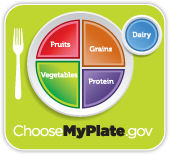Gluten-Free Grocery Shopping
A trip to the grocery store in search of gluten-free foods can be an overwhelming experience, especially these days when new gluten-free food products are popping up everywhere. Simply following a few tips can get you in, out, and on your way to a healthy lifestyle. Check out these ideas from FEED the next time you grocery shop!
Start at the produce section; fill up at least half of your cart with fresh fruits and vegetables.
One of the keys to healthy eating is creating balance. The MyPlate campaign was established as part of the 2010 Dietary Guidelines for Americans to help consumers make better food choices. As a replacement for the frequently misunderstood food guide pyramid, MyPlate depicts the importance of consuming a variety of food groups at each meal; emphasizing half of our plate should consist of fruits and vegetables, one-quarter whole grains, and one-quarter lean proteins.

Check out seasonal products lists like this to determine what is in season in your area. By choosing seasonal produce, you will get the most nutrient-packed produce at the lowest cost. That is, the longer it takes food to travel to the grocery store, the higher the price for the consumer.
Aim to choose at least three servings of dark green vegetables (spinach, kale, broccoli, romaine, Brussels sprouts, Swiss chard) and about three servings of red/orange vegetables (carrots, sweet potatoes, squash, bell peppers) per week. Typically, the more colorful choice equals richer vitamin/mineral content.
Stick to your list
It is easy to get side-tracked when at the grocery store with the various tempting displays, samples, or promotions. Don’t let this sway your purchases! Focusing on filling your cart with fresh produce, lean proteins, whole grains and low-fat dairy/dairy alternatives should be the main focus. Avoiding the “extra” cookies, crackers, chips, and dips will only fare you better in the end. Not only from a nutritional perspective, but also should lower the cost of your grocery bill.
In addition to fresh produce, fill up your cart with lean meats, poultry, fish, and even alternative protein sources such as tofu and beans. Do you seem to purchase the same foods week after week? Try to focus on a theme each weeknight rather than the same meal, and increase your repertoire. Instead of serving the same old gluten-free pasta and tomato sauce on Wednesdays, for example, expand your variety to include eggplant parmesan, pasta fagioli, or even homemade pizza night.
Avoid loading up on “snack foods”; Shop the perimeter of the grocery store.
In recent decades, snacking (particularly by adolescents) has increased. Reports have estimated adolescents consume on average 526 calories (about ¼ of the day’s total) from snacks. With this large proportion of calories coming from snacks, it is essential to keep nutrient-packed options in the household. Instead of refined carbohydrate gluten-free chips, crackers, or pastries, look for whole grain options such as low-fat popcorn, or all-natural dried fruit/nut bars. Typically the perimeter of the grocery store contains less processed options including the aforementioned fresh fruits/vegetables, lean proteins, and also includes low-fat dairy products/dairy alternatives including yogurt, cottage cheese, or cheese.
Bottom Line: When shopping for a gluten-free diet, you need not consume a diet full of processed foods including refined-carbohydrate cereal, breads, and pasta. But rather, focus on balance and think of MyPlate on your next grocery store trip!
Related Links:
Spring Cleaning (your diet) – April 5, 2013
Gluten-free Diet: Is it for you? – February 12, 2013